 |
August 2012
|
August 2012 // Volume 50 // Number 4 // Research In Brief // v50-4rb4
The Role of Extension Nutrition Education in Student Achievement of Nutrition Standards in Grades K - 3: A Descriptive Evaluation of a School-Based Program
Abstract
This article reports the results of a descriptive evaluation of the impact of an in-school Extension nutrition education program in a small, very rural county. The evaluation focused on understanding the nature of the role the Extension educator plays in delivering nutrition education, the impact of the program on student learning and achievement of nutritional benchmarks, and the value of the collaboration between the schools and Extension. Results indicate that the Extension nutrition program is a valuable resource for schools in the county and that the program supports student achievement of nutrition education standards.
Introduction
One of the biggest concerns at the forefront today is childhood obesity. Currently, approximately 17% of youth age six to 17 are considered obese (Federal Interagency Forum on Child & Family Statistics, 2009). Obesity rates for children age six to 11 increased from 6.5% to 19.6% between 1980 and 2009 (Ogden, Carroll, Curtis, Lamb, & Flegal, 2010). Research shows that obese children have an increased risk for health problems and are more likely to become obese adults (Centers for Disease Control, 2010).
Childhood obesity is a complex problem, and interventions to address the problem include nutrition education, increased access to and consumption of nutritious food, increased physical activity, and targeted weight loss programs (Hadley, Hair, & Dreisbach, 2010). Because children spend the majority of their days in school, schools provide a perfect place for teaching children about healthy eating. Increasingly, schools are interested in innovative programs that focus on improving student nutrition (National Institute of Medicine, 2005).
In addition, states are beginning to articulate student-learning benchmarks related to nutrition education. In Oregon, the State Department of Education has developed state educational standards for the promotion of healthy eating for students from kindergarten through high school (Oregon Department of Education, 2010). In addition to understanding aspects of healthy eating, the standards focus on dietary self-management, understanding social influences, goal setting, and advocacy for healthy food.
Providing education in nutrition and healthy eating has long been a hallmark of Extension programming, and nutrition education is needed now more than any time in our history as we work to counter the negative effects of nutrition-related concerns that have emerged in the past 20 years. Through partnerships with local schools, Extension nutrition educators have been successful in improving the diets of school-age children (Roth-Yousey, Caskey, May, & Reicks, 2007).
This article reports the findings from a descriptive evaluation of an Extension nutrition education program conducted in a small, rural county. The program has been in place in the county since 2005, with 1,464 elementary school children participating in the program between 2005 and 2009. County-based Extension educators partnered with the 20 teachers from five schools, which represent most of the elementary schools in the county, to deliver in-school nutrition education programming. Using grade-specific curricula, educators spent time in the classroom conducting nutrition education lessons.
Evaluation of the Nutrition Education Program
In 2010, after conducting the Extension nutrition education partnership with schools for 5 years, we decided to assess the impact of the program. Three objectives guided the focus of the evaluation:
- To understand the need for an Extension educator to deliver the program, rather than just providing the teacher with curriculum to use.
- To understand the impact the program had on student achievement of state educational standards related to nutrition and healthy eating.
- To understand the importance of the collaboration between the Extension staff and classroom teachers in providing nutrition education.
Participants and Data Collection
Data were conducted using a commercial on-line survey system. Using an on-line method was particularly useful in this evaluation because it allowed data to be entered directly by the respondent, which reduced the data entry burden on busy county staff and allowed for easy sharing of data and results between the two authors, who are separated physically by an 8-hour drive. Current contact information was available for 18 of the 20 teachers. The 18 who were contacted all still lived in the county, although not all were currently teaching.
Teachers were sent an e-mail invitation to participate in the survey. The e-mail contained information about the project, a letter of informed consent, and a link to the survey site. Reminder e-mails were sent to teachers who did not initially participate. Thirteen of the 18 teachers completed the questionnaire, for a 72% return rate.
Instrument
The evaluation instrument was comprised of two sets of items. The set related to the state's educational benchmarks in the area of "Promotion of Healthy Eating" for grades K-3 and 4-5. Respondents were asked to estimate the percentage of their students they perceived had achieved each of the benchmarks as a result of the Extension nutrition education partnership. Respondents could answer: 1) less than 50%; 2) 51-60%; 3) 61 to 70%; 4) 71-80%; 81-90%; and 91-100%. Going further, respondents were then asked to rate how much they thought the Extension nutrition education program supported students' achievement of the standard: 1) no support for achieving this standard; 2) some support; 3) moderate; and 4) high support. Cronbach's alpha internal reliability for the achievement for grades K-3 was .72, and .86 for grades 4-5.
The second set of items asked about the value of and need for Extension to provide nutrition education curriculum in the school district. Respondents were asked rate each item on a one to five scale: 1) Strongly disagree; 2) disagree; 3) neutral; 4) agree; and 5) strongly agree. Examples of these items included: "The County Extension office is the only agency that offers in-school nutrition education programming in my area," and "I rely on having an Extension nutrition educator come to my classroom to teach." Cronbach's alpha internal reliability for the Extension support items was .86.
Results
Impact of Program on Student Achievement: Grades K-3
Nine of the 13 teachers (69%) reported participating in the Extension nutrition program with grades kindergarten through three (K-3). First, teachers were asked to estimate the percentage of students who achieved each of the five state educational standards for the promotion of healthy eating in grades K -3. Teachers were then asked to estimate how much the Extension nutrition education program supported the achievement of the nutrition and healthy eating educational standards for grades K-3.
Teachers rated student achievement of Oregon Educational Standards related to nutrition and healthy eating highest for examining USDA guidelines (78% rated achievement above 80%) and choosing a variety of foods (56% rated student achievement above 80% for this standard). Teachers rated achievement of the remaining standards considerably lower.
Second, teachers were asked to rate how much the nutrition education program supported the achievement of each standard. The results indicate that the program was most supportive in helping students to examine the USDA guidelines (89% rated this "high") and to learn how to choose a variety of foods from the different USDA food groups (78% rated this "high"). Figures 3 through 7 show teacher estimates of student achievement and ratings of how well the nutrition program supported achievement of each of the K-3 standards.
Figure 3A.
Percent of Students Who Can Examine the USDA Guidelines
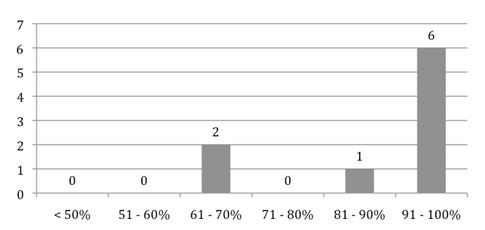
Figure 3B.
Level of Program Support for Helping Students Learn to Examine the USDA Guidelines
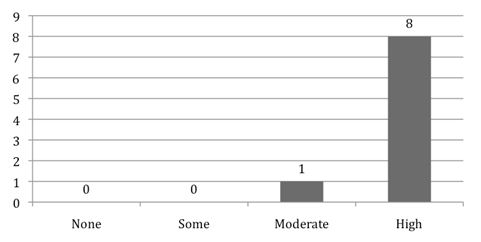
Figure 4A.
Percent of Students Who Can Choose a Variety of Foods
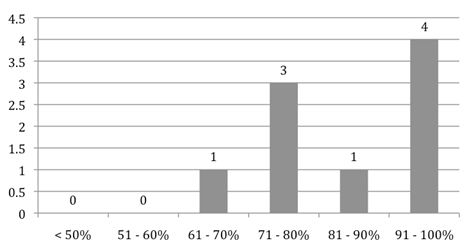
Figure 4B.
Level of Program Support for Helping Students Learn to Choose a Variety of Foods
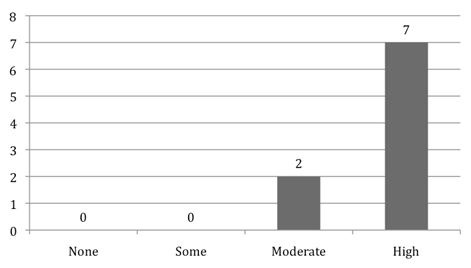
Figure 5A.
Percent of Students Who Can Describe Advertising Strategies

Figure 5B.
Level of Program Support for Helping Students Learn to Describe Advertising Strategies
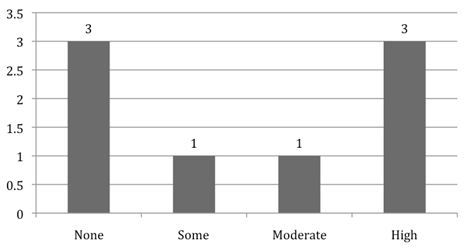
Figure 6A.
Percent of Students Who Set a Short-Term Eating Goal
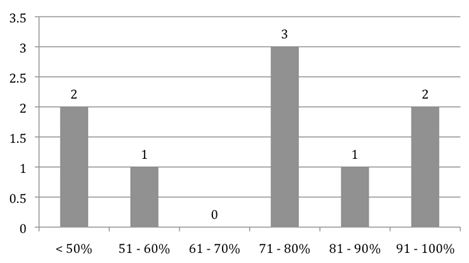
Figure 6B.
Level of Program Support for Helping Students Set a Short-Term Eating Goal
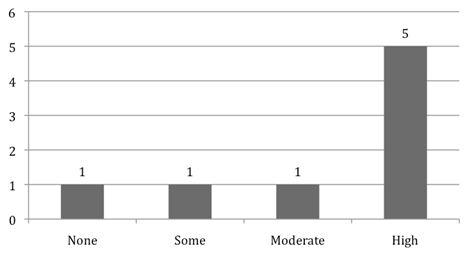
Figure 7A.
Percent of Students Who Advocate for More Fruits and Vegetables at School
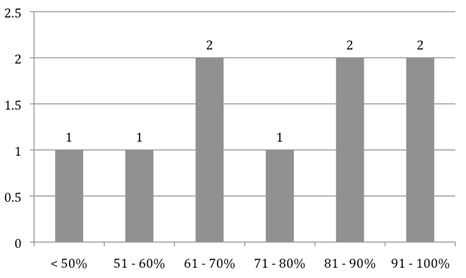
Figure 7B.
Level of Program Support for Helping Students Learn to Advocate for More Fruits and Vegetables at School
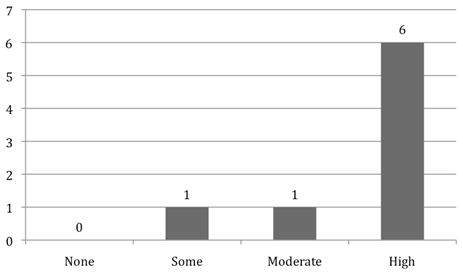
Importance of Collaboration Between Schools and Extension Nutrition Education Program
Respondents were asked about the importance of having an Extension nutrition educator facilitate the lessons in the classroom. Of the respondents, 58% said they "disagreed" or "strongly disagreed" that they only needed the curriculum, and not the Extension educator to deliver nutrition education. Conversely, 92% of respondents "agreed" or "strongly agreed" that they rely on the Extension nutrition educator to teach the curriculum in their classroom. Figures 8 and 9 below show the frequency of teacher level of agreement as to whether the curriculum only is needed, and if the teacher relies on the Extension nutrition educator to conduct the lessons.
Figure 8.
Needs Curriculum Only
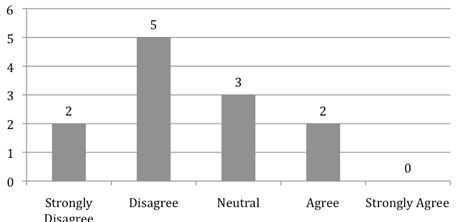
Figure 9.
Needs Educator to Conduct Lessons in Addition to Curriculum
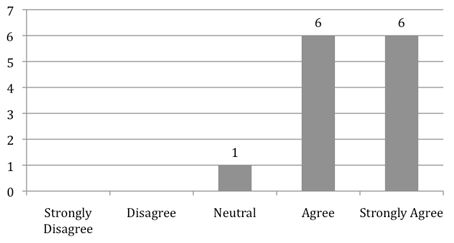
All of the respondents "agreed" or "strongly agreed" that the Extension nutrition education program plays a critical role in helping students achieve learning related to nutrition and healthy eating. Similarly, 100% "agreed" or "strongly agreed" that the program enhances the teacher's ability to provide nutrition education to students. Nine teachers (69%) strongly agreed that Extension is the only agency that offers in-school nutrition education programming.
We have been very fortunate in the staff that has provided the Nutritional Education programs. They are highly effective because they have come with classroom management skills, a kind and considerate manner, and very motivated activities to engage the entire classroom.
Conclusion
The results presented in this article come from a small, but representative sample of teachers who partnered with Extension to deliver in-school nutrition education programs. Given the small and descriptive nature of the study, caution should be used when generalizing the results to other situations. However, the results of this evaluation provide important information about the potential impact of the nutrition education program offered by the county Extension office in a small, very rural county.
Specifically, the results indicate:
- The program is targeting the age group that research shows can be most affected through nutrition education.
- The program has significant breadth, reaching elementary schools in all three districts in the county, as well as one private school.
- The program has significant reach by providing in-school nutrition education to the majority of school age children (K-5) in the county.
- The program appears to provide support for some of the Oregon educational standards for nutrition and healthy eating.
- The program is well received and appreciated by teachers.
- The program structure, which includes both curriculum and an educator to conduct the lessons, appears to be the ideal method of providing this program to schools.
References
Centers for Disease Control (2010). Childhood overweight and obesity. Retrieved 2010 from: http://www.cdc.gov/obesity/childhood/index.html
Federal Interagency Forum on Child & Family Statistics (2009). America's children: Key national indicators of well-being. Washington, DC: Author.
Hadley, A. M., Hair, E. C., & Dreisbach, N. (2010). What works for the prevention and treatment of obesity among children: Lessons from the experimental evaluations of programs and interventions. Washington DC: Child Trends.
National Institute of Medicine (2005). Preventing childhood obesity: Health in the balance. Washington, DC: The National Academies Press.
Ogden, C. L., Flegal, K. M., Carroll, M. D., & Johnson, C. L. (2002). Prevalence and trends in overweight among US children and adolescents, 1999-2000. Journal of the American Medical Association, 288(14), pp.1728-1733.
Roth-Yousey, L., Caskey, M., May, J., Reicks, M. (2007). Modifying beverage choices of preadolescents through school-based nutrition education. Journal of Extension [On-line], 45(3) Article 3RIB7. Available at: https://www.joe.org/joe/2007june/rb7.php




